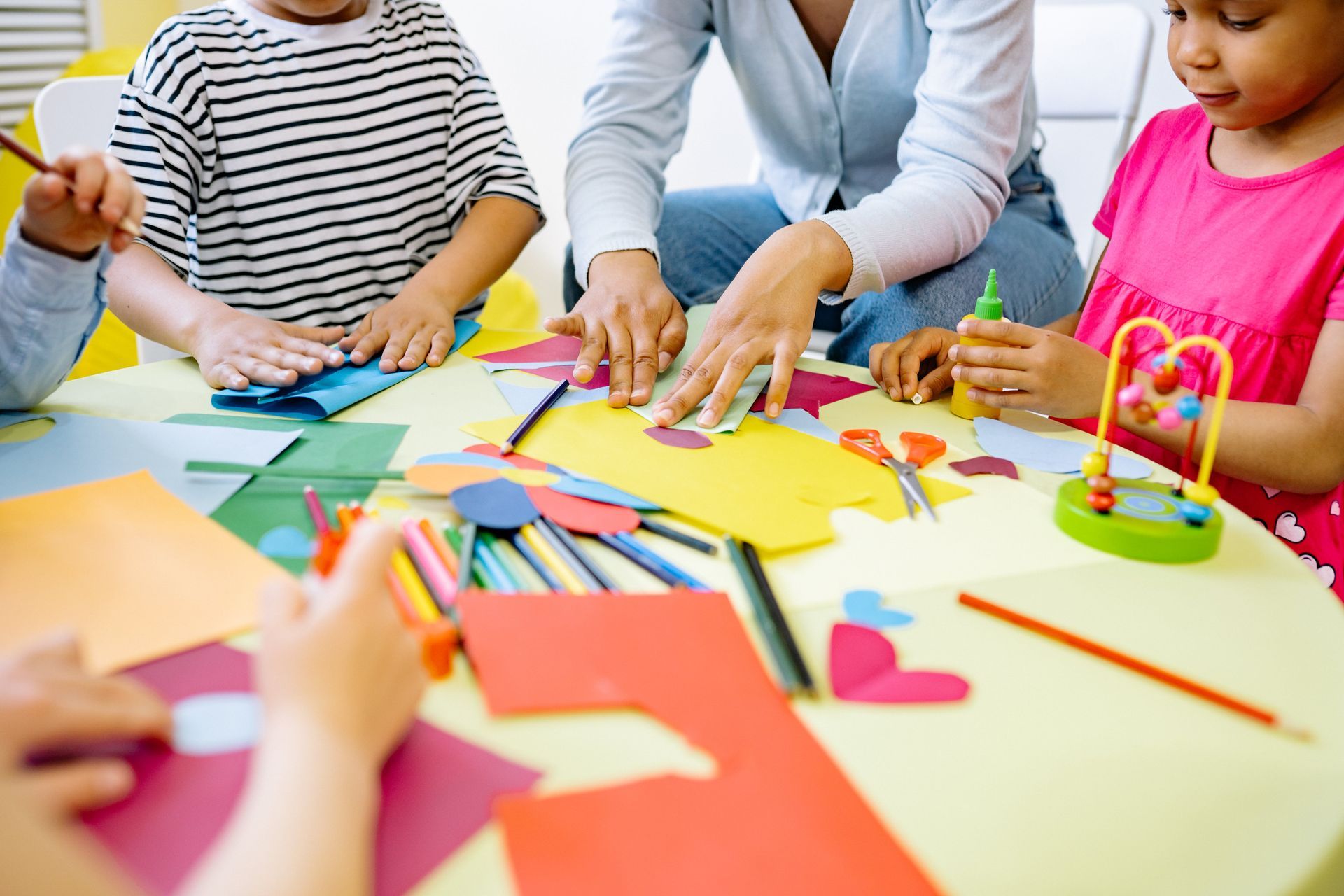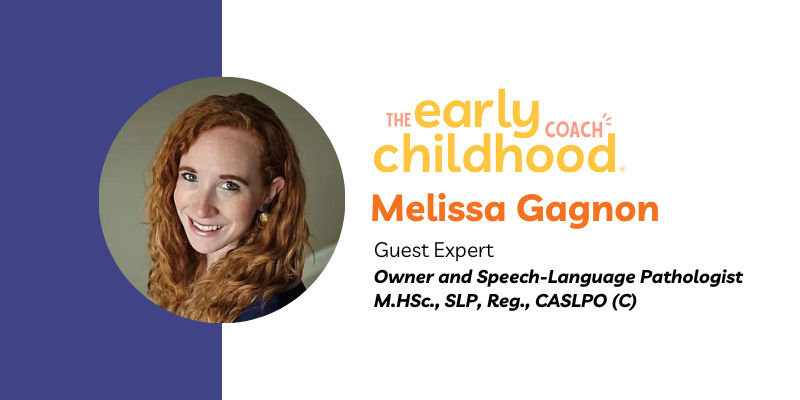Enhance Literacy in the ECE Classroom with Melissa Gagnon
Meet Melissa Gagnon, a certified Speech-Language Pathologist (SLP) with over a decade of experience working with kids and adults. We sat down with Melissa, and she wowed us with insights on early interventions that support lifelong literacy. Read on for simple strategies you can implement right away to make an impact on early literacy in ECE.
Tell us all about you and the work you do to support literacy.
My current work focuses on literacy in children, which is very much tied to speech and language development. About halfway into my SLP career, I noticed that kids with speech and/or language delays often struggled with reading and there were few options available for supporting these children. It was due to this gap that I decided to pursue continuing education and began to realize just how much speech, language, and literacy are connected. I wanted to learn more about the science of reading and how I could support kids on their journey to become successful readers through research-based therapy. Children struggling with literacy needed extra support, and parents often struggled to figure out why they were falling behind. They would tend to question their child’s abilities and invest in tutors and/or other services, not necessarily how literacy was being taught.
What drives your passion for enhancing literacy?
I struggled as a young reader myself, so I relate to kids who struggle a lot with reading. It was difficult being a poor reader, as this affected other areas of my life, such as social interactions. We know literacy is deeply connected to academics and quality of life, and literacy rates in Canada are dropping. This is a problem because literacy is a part of everyday life, and a certain level of literacy is required to complete tasks of daily living. There are five literacy levels, with level three being the bare minimum of proficiency. Research has shown that increasing literacy rates by 1% in Canada would create an $18 billion/year increase in the GDP (Gross Domestic Product). Literacy has a lifelong impact on quality of life, which is why I'm so passionate about it.
>> Learn more about Melissa’s early struggles with reading and her journey to supporting literacy on her blog.
What should every ECE know about literacy in the early years?
One of the biggest misconceptions is that literacy is learned in the same way as language. Most people believe we just need to expose kids to words and letters and read to them until they eventually pick it up. We now know that is not the case. Reading is not learned through exposure; it requires different areas of the brain to make connections. We must establish those neural pathways through an explicit and direct teaching approach. In fact, did you know that 95% of students can learn to read when taught using instruction and programs based on the science of reading? Only 30% of students will learn how to read without any instruction (through exposure only).
In your work, what are some things you see happening that need to be addressed in the early years?
When most people think of literacy, they think of teaching kids the ABCs. But that is just one core component of literacy (phonics). There are five core components of literacy: phonics, phonological awareness, fluency, comprehension, and vocabulary.
Phonics is fantastic, but we focus a lot of energy on that, and we don't necessarily do it correctly. Letter sounds, not letter names, are the most important aspect of phonics. This includes teaching all 44 sounds of the English language, not just the 26 sounds of the alphabet. Using lowercase letters is also important because kids are exposed to them more frequently. Phonics is also best learned through a multisensory approach.
Many people are not familiar with the term, but phonological awareness is the most significant predictor of a child's literacy success down the road. It is the ability to understand and recognize sounds and to manipulate them through rhyming, blending, segmenting, and substitution.
The good news is that you can work on phonological awareness skills with children as early as three years old; this may even be before they know letter names and sounds. For example, if you are on a walk with your kids, you can play 'I Spy' and say, "I spy a 'c' 'aa' 't,' slowly sounding out each letter sound, and ask them to blend these sounds into a word to determine what you see (cat). It's a fun detective game for kids, and it teaches them how to blend sounds. There are many other activities that you can do in a child’s everyday life to help build the foundation of literacy as well!

What makes a "literacy-rich" classroom or learning environment?
Focusing on phonological awareness is a powerful way to support early literacy. You can incorporate almost all the phonological awareness skills when reading books in the classroom. Let's say I'm reading a book about a farm. If there is a sheep on the first page, before I show them the picture, I can say, "Ok, I see an animal and I want you to listen to these sounds and guess what it is: 'sh' 'ee' 'p.' Who knows what animal it is?" Then let them guess the animal by blending the sounds together to make a word. I can work on rhyme production, which is another part of phonological awareness, by asking, "Can anyone tell me a word that rhymes with sheep?" If they're stumped, we can work on rhyme identification. "Do sheep and meep rhyme? What about sheep and keep?" We could take this one step further and work on sound manipulation by asking the students, “What new word would I get if I removed the ‘sh’ sound at the beginning of ‘sheep’ and added a ‘p’ sound?” With one activity, you can cover all the aspects of phonological awareness.
Literacy is very visual, meaning it requires a child to picture the number of sounds in words and what happens when we change those sounds. The great thing about this is that we can work on literacy skills without requiring children to sit down at a desk with words, a book, and/or pen and paper.
>> Enhance your classroom library with
Zoey has an Allergy, a children’s book written by The ECC’s founder Anisha Angella!
What should literacy look like for children at two years old? Three years? And four to five years?
It's challenging to assess literacy at young ages as children are just starting to explore books. They will start to understand which way you hold a book, that you read from left to right, the difference between a word and a picture, etc. It is mostly about exposure at age two and modeling early literacy skills, such as phonological awareness. At age three, if they're struggling with putting sounds together or holding the book the wrong way or upside down, we want to keep an eye on that.
For ages three and four, I'd expect them to start to identify their name and begin to spell their name, maybe not pen to paper, but being able to find tiles with the letters for their name or write their name in sand or dough, which also incorporates fine motor movement.
Ages four and five are at that sweet spot for learning literacy. If we can work on blending, segmenting, playing with sounds, and making it fun instead of using traditional flash cards and ABCs, we can support skills they'll need when they're ready to read. This is also a great age to introduce new vocabulary, which will help support a child’s ability to become a fluent reader who comprehends the information they are reading.
What resources would you recommend to the ECE community to learn more about literacy?
There's a great podcast called Sold a Story that shares why kids are struggling with literacy. It examines the Balanced Literacy programs widely used in the education system and the problems it creates in early readers. It is a phenomenal podcast for educators and parents alike.
I also encourage educators to pursue continuing education or to gather more information about literacy. Make sure you find resources based on the science of reading. When you look for something to implement in the classroom, you want to make sure it's going to help the majority of students. Balanced Literacy programs only help a small percentage of the population.
If you want to make sure you're providing the best support for young students, take a workshop! I lead an ECE workshop that teaches a research-based approach to literacy and will include resources, education, and a live Q&A. We created this workshop to equip educators with all these wonderful resources and ideas for supporting early literacy in the classroom.
Melissa has so many amazing strategies for supporting literacy that we couldn't fit them all in! Check out her work at Empower Communication Services and be sure to follow her on Instagram for regular updates and insights on all things literacy.











